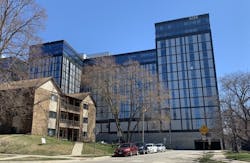Even smaller locations like Iowa City, IA, which was the second-fastest growing metro area in Iowa between 2010 and 2016, are seeing a demand for new housing and infrastructure.
As populations expand and cities look to accommodate the influx of people, what kinds of buildings are being constructed in response?
Although I’ve traveled to all three cities mentioned above, I’ve recently looked at Iowa City as an example, considering the notable changes to its landscape.
Iowa City has over 75,000 residents of all ages, but as home of the University of Iowa, which had more than 33,000 students in 2018, the city’s median age is 26.2 years old.
I’ve noticed a large increase in the number of apartments and mixed-use buildings that have opened up, are currently under construction or are getting ready to break ground. This is likely due to the majority of the Millennial generation renting its housing versus owning it.
Iowa City’s Eye Is on the Sky
The Chauncey Tower is an example of one modern building being built to fit the wants and needs of the local community. It’s a 15-story, mixed-use tower that will feature 65 residential units, a hotel, restaurant, bowling alley and movie theater, and a connecting park.
[On topic: Secret to Attracting Millennial Renters]
The building’s height was heavily debated when first proposed, as Iowa City has fewer than a handful of buildings higher than 15 stories. However, development was controversy-free in 2018, and the tower is expected to open in August.
RISE is another notable building that was constructed diagonal to my former apartment.
Some local citizens have had concerns as to how these big and bold projects are changing Iowa City’s skyline. City Council member John Thomas points out that by concentrating higher densities on certain development sites, high-rise buildings reduce the extent and vibrancy of the urban sphere of redevelopment envisioned in the plan.
He notes how projects, such as the Chauncey Tower and RISE, as high-rise buildings could have potentially negative impacts, including:
- Higher building costs, which leads to higher rent (Iowa City residents already struggle with high rent and low vacancy rates)
- Increased shadow effects and loss of sky views at street level (see my personal example above)
- Obstructed views of civic landmarks—Iowa City is home to the Old Capitol, the state’s first capitol building
- Increased speculation on land values
Regardless of controversy, a combination of mixed-use buildings, hotels, parking spaces and more continue to pop up and change Iowa City’s skyline. I will say that many of the buildings are structurally sleek and aesthetically pleasing to look at when walking or driving by.
However, I see the concern for obstructed views.
During my four years of residence in my “tiny” apartment, I watched an empty parking lot that was used for city employees and offered spectacular sunset views turn into a much larger parking ramp.
The new ramp has 600 parking spaces and 28 residential condominium units surrounding it.
[Even more: Glass Envelope Parking Garage]
Unlike traditional concrete parking facilities, this modern design features elements like perforated aluminum panels that filter out headlights and safety additions like glass-encased staircases—it even won a design award from the American Institute of Architects Iowa Chapter.
Iowa City’s Sustainability Push
Among all the new construction projects, Iowa City was recently announced as one of 75 STAR-certified cities and counties to have joined the family of LEED for Cities and Communities. The city received a 4-STAR community rating for sustainability in excellence in 2016.
The STAR Community Rating System is under the USGBC and has merged into the LEED for Cities—a global program that advances healthy, green and economically strong cities and communities.
[Ahead of the curve: World’s First Powerhouse Hotel in the Arctic Circle]
“We have used the STAR framework to help us move forward on climate goals,” says Brenda Nations, Iowa City’s sustainability coordinator. “We now have a climate action plan as of September 2018.”
She adds that the city already has a few LEED-certified buildings including two fire stations (Gold) and the East Side Recycling Center Education Center (Platinum).
BUILDINGS Podcast
LEED Zero: New Designation for Net Zero
[podcast]
Learn more about this new designation, including the requirements behind it and how it can benefit your building. Listen now >>
Kumi Morris, Iowa City’s facilities manager, states that the city is working toward LEED certification for more commercial buildings, including the new Public Works Facility.
“The project is bid, and we are hoping to attain LEED Silver or above,” she says.
It’s evident that Iowa City is moving forward to meet the demands of its growing population, regardless of the pushback residents might give along the way. As urban areas all around the country continue to grow, it’s important for facility managers to consider who is moving to the area and what types of buildings the people need.
It also doesn’t hurt to take into consideration the most current green building standards for any upcoming projects. Knowing how this growth will affect future plans and the local community will help projects move forward and enable you to continue to define your own skyline.
Two handpicked articles to read next:
About the Author

Adrian Schley
Staff Writer
Adrian Schley has been writing for interiors+sources magazine since March of 2018 and creates content for the BUILDINGS team. She earned her BA in journalism at the University of Iowa, where she also studied English.
